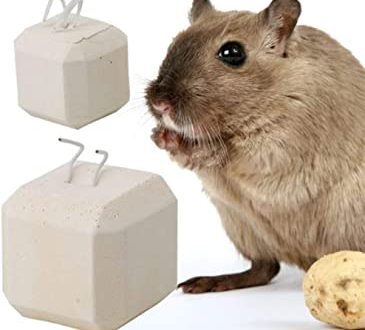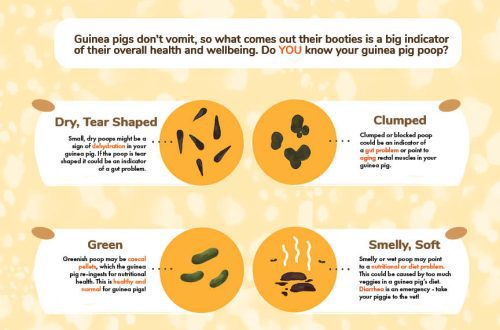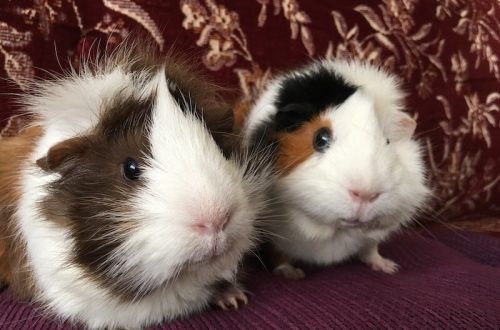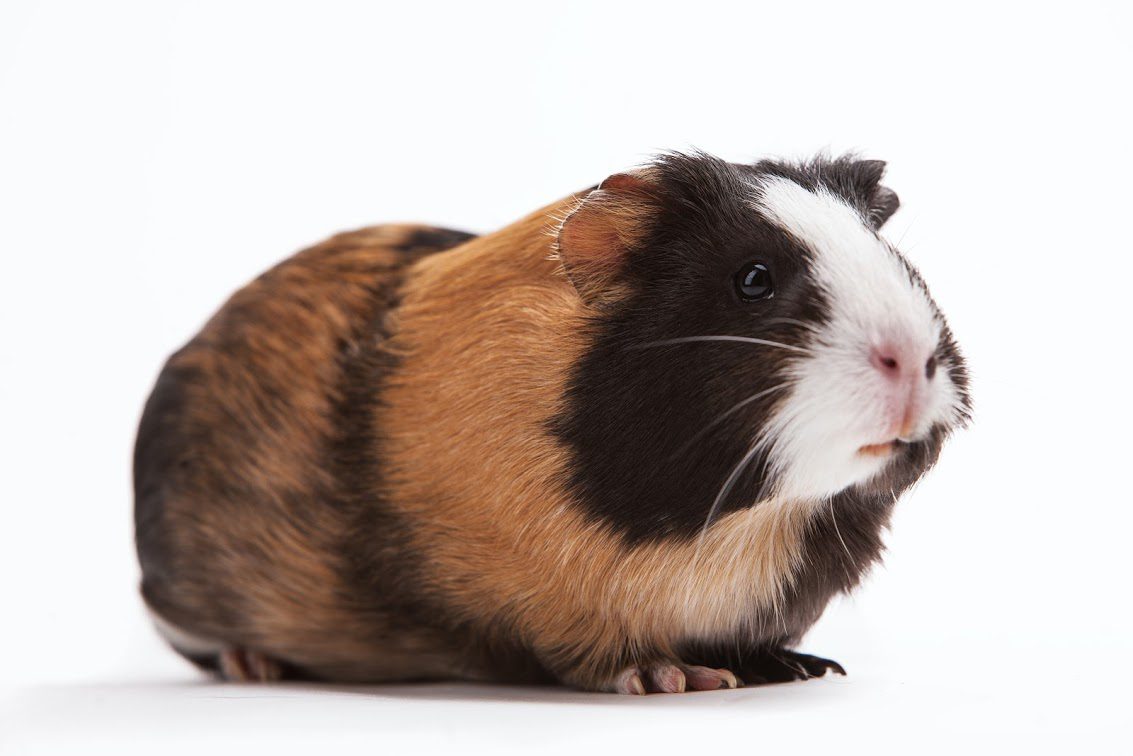
גיני חזיר: זאָרגן און וישאַלט אין שטוב פֿאַר ביגינערז
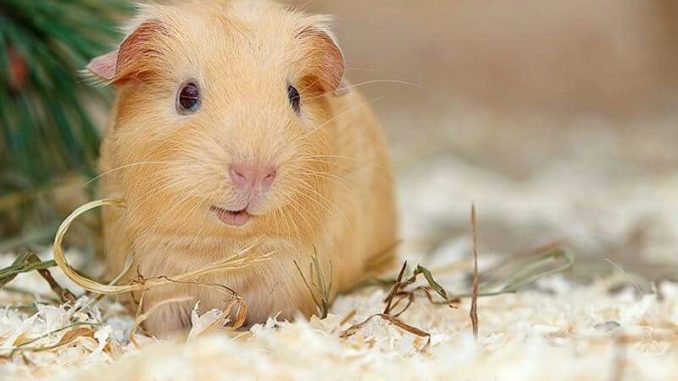
Sociable, friendly and funny animal will be an excellent pet for both children and adults. But before you take care of a small rodent, you should learn everything about guinea pigs in order to avoid many mistakes in their maintenance, which are often made by inexperienced owners.
ינהאַלט
- Keeping Guinea Pigs at Home for Beginners: Tips and Tricks
- Preparing for a Guinea Pig
- Choosing a home for a guinea pig
- Guinea pig home improvement: a list of necessary and additional accessories
- What and how to feed a guinea pig
- Guinea pig care tips
- Games, training and domestication of a pet
- How to properly handle a guinea pig
- Video: how to care for a guinea pig at home
Keeping Guinea Pigs at Home for Beginners: Tips and Tricks
Many people decide to get these rodents, believing that they do not require special care and are unpretentious in keeping. But, like any pet, the guinea pig needs care and attention, and it needs to provide comfortable living conditions, proper care and proper nutrition.
Features of the care and maintenance of guinea pigs, which the future owner needs to know about:
- A guinea pig cannot live in a cardboard box or wooden box! For a small pet, you need to purchase a cage or terrarium;
- bringing a rodent home, you should leave him alone, giving him time to adapt to an unfamiliar environment. You can not immediately take a pet in your arms and stroke it. Or allow him to freely walk around the apartment, because a frightened rodent will definitely try to hide in a secluded place, from where it will be difficult to get it. The animal must first get used to the new home and the smell of the owner;
- you can only feed animals with special food, and not food from your table. Particular attention should be paid to the list of prohibited foods for these rodents;
- if there is a cat or a dog in the house, the owner must ensure that the cage of the animal is tightly closed, otherwise the pig may become a victim of a fluffy or four-legged predator;
- letting the pet go for a walk around the house or taking it with you to the sofa, you need to look after him so that he does not gnaw on wires, furniture or wallpaper;
- guinea pigs are not aggressive and friendly, so the fluffy animal will be an excellent pet for a child. But trusting the care of a rodent should be children who are 8-10 years old, since the animal must be handled carefully and carefully.
Important: pigs need not only the care and care of the owner, but also communication with him. Therefore, if the owner is not ready to devote time and attention to the animal, it is better to refuse to purchase it.
Preparing for a Guinea Pig
For the appearance of a small pet in the house, you should prepare in advance and create comfortable conditions for the rodent. The owner must ensure that the animal has a spacious home equipped with all the necessary accessories.
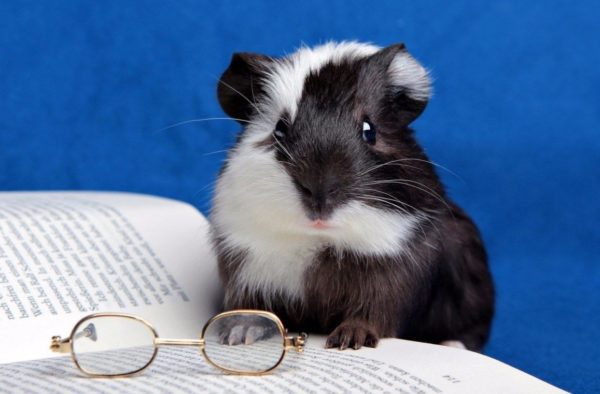
Where to begin? First of all, you should choose a suitable corner in which the cage of the guinea pig will be located. It should be borne in mind that the animals do not tolerate heat well, so their home should not be placed in the immediate vicinity of the battery or in a place where direct sunlight falls. Drafts are also harmful to the health of a fluffy pet, as a result of which it is not recommended to place the cage under the window.
The most comfortable temperature for keeping these rodents is 18-20 degrees.
List of items that need to be prepared for the appearance of a guinea pig in the house:
- convenient and comfortable cage;
- attributes for feeding a pet (feeder, drinker, sennitsa);
- באַשיצן הויז;
- feed and hay;
- cell filler;
- stone for grinding teeth;
- אידיש;
- comb (if the pig is a long-haired breed);
- carrying (for visiting the veterinarian or traveling).
Important: when choosing a cage and necessary and optional accessories, the owner must pay attention to their safety. Sharp edges, small holes, coating of housing parts or products with varnish and paint are unacceptable, as they can lead to injury to the pet or provoke food poisoning.
Choosing a home for a guinea pig
When kept at home, a small pet spends most of the time in his home, so it should be convenient, comfortable and safe.
Housing options for guinea pigs:
- צעל;
- טעראַריום;
- aviary;
- plastic container (dune).
Each of these options has both advantages and disadvantages. And before choosing one of them, the future owner should study all the nuances.
שטייַג פֿאַר גיני חזיר
Experienced owners of furry rodents believe that it is most convenient to keep these rodents in a cage.
Basic requirements for a cage:
- it must be spacious. The optimal dimensions of the cage: length – 90 centimeters, width – 60 centimeters, height – 40 centimeters;
- it is desirable to choose a cage with a plastic pallet, and not with a slatted bottom, in which the animal’s paw can get stuck;
- housing bars should be metal, not wood or plastic. After all, a pig is still a rodent and it will not be difficult for her to gnaw through wood or plastic in order to get out of the cage;
- multi-level cages for keeping guinea pigs are not suitable. These rodents are not adapted to climb high shelves and do not know how to jump. Even if the animal climbs onto the shelf, it will not be able to go down on its own. And a fall from a great height is fraught for him with injuries and fractures, up to the death of the animal;
- a cage with dimensions of 90x60x40 is suitable for one guinea pig. With the joint maintenance of two or more pets, the dimensions of the housing must be at least 120x80x40.
The cage can be called an almost ideal home for these rodents. It has good ventilation. The pig will not be able to get out of the cage and roam freely around the apartment. Such housing has only one drawback: food residues, hay, animal feces and bedding pellets fall through the bars, so the floor near the cage will have to be swept every day.
Terrarium for guinea pig
A spacious glass terrarium can be suitable as a home for a fluffy pet if the side walls are made of metal mesh, and not glass. The terrarium is good because it is easy to clean and the floor around it will not be littered with sawdust or food husks.
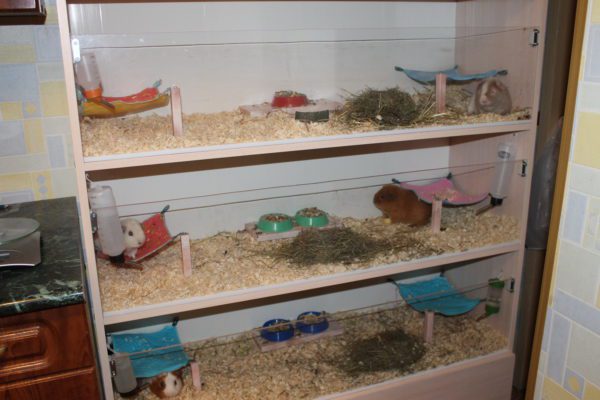
But all-glass terrariums or aquariums are not the best housing for a guinea pig, as they lack oxygen circulation, and the litter will always be damp due to poor ventilation.
Enclosures and dunes for pets
Some owners keep their pets in open spacious enclosures equipped in the room. In such a dwelling, the pig will be comfortable, but you should make sure that the height of the walls is at least 40 centimeters. Otherwise, the animal will easily get over them and arrange a walk around the apartment. Also, such a dwelling is not suitable for furry animals if there is a dog or cat in the house.
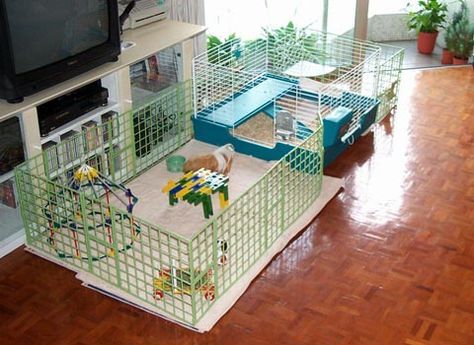
Dune is a construction of a transparent plastic container with a lattice hinged lid. But experts do not recommend using them for keeping guinea pigs. The dunes are small and cramped, the air flow in them is limited, and rodents in such housing do not feel comfortable.
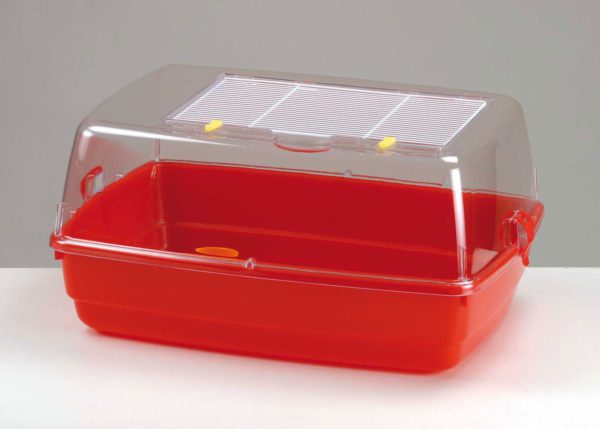
Guinea pig home improvement: a list of necessary and additional accessories
On the shelves of pet stores laid out a variety of products and accessories for guinea pigs. And it can be difficult for a novice owner to navigate with such an abundance of items and decide what would be appropriate in a pet’s cage. Therefore, information will be useful to him, what accessories are necessary for keeping these rodents, and what things can be dispensed with.
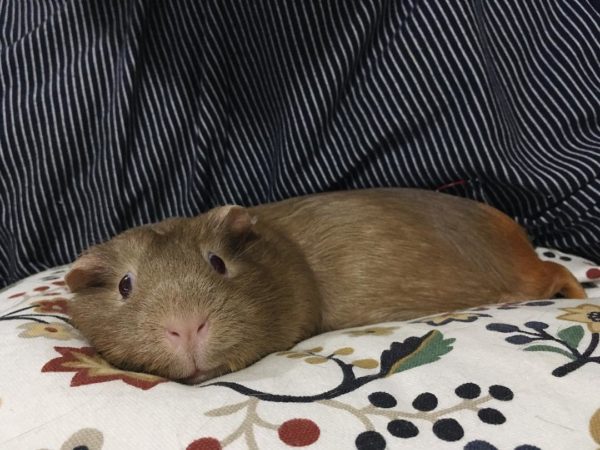
To keep a rodent you need to purchase:
- feeder. They are floor and suspended and it is better to opt for the second option. Animal excrement and litter granules get into the feeders standing on the floor, which contaminate the food.
- Sennitsa. Hay is the main food of furry animals and it is advisable to put it in a special sennitsa, and not throw it to the bottom of the cage.
- Drinker. As in the case of the feeder, it is recommended to choose a hanging drinker, rather than a regular water bowl.
- House. The pig needs a shelter where she can hide from prying eyes and annoying attention.
Additional cage accessories:
- toys (wooden cubes or paper balls);
- shelter tunnels;
- hanging hammock;
- soft bed;
- mineral or salt stone for grinding teeth.
Important: items such as a running wheel or a walking ball are contraindicated for guinea pigs. Animals are not adapted to move in them, and can damage the spine or get a broken leg.
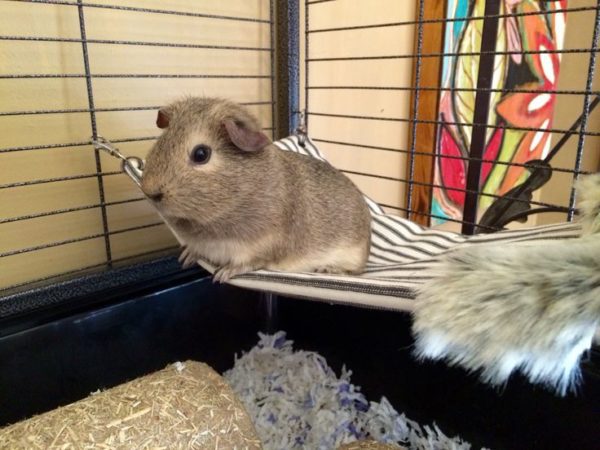
What and how to feed a guinea pig
Care and maintenance of a fluffy rodent at home is not limited to the design of the cage and the choice of accessories.
A very important point is the selection of the right diet for the animal. Unfortunately, inexperienced owners do not pay due attention to feeding the animal, believing that any food intended for rodents is suitable for them.
But the main food of herbivorous guinea pigs is hay and plants, not cereals. Raw vegetables must also be present in their daily menu. Therefore, food for rats or hamsters is not suitable for pigs; moreover, it can harm their health.
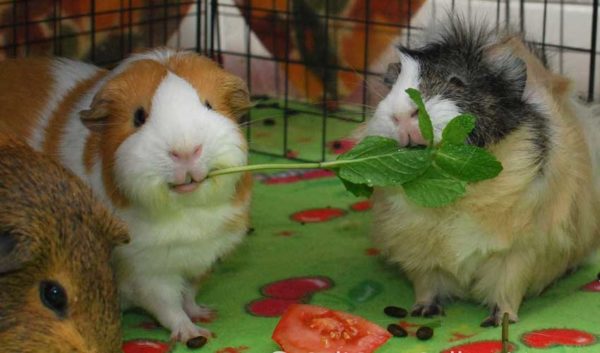
The diet of rodents should include:
- quality dry hay;
- fresh field herbs and green leaves of garden and meadow plants. Pigs can dandelion, clover, nettle, alfalfa, burdock, lettuce, chamomile, dill;
- fresh vegetables (pumpkin, zucchini, carrots, cucumber, beets, tomatoes, celery, cabbage);
- branches of trees and shrubs. For example, raspberries, blueberries, apple trees, willows, pears, ash, maple;
- fresh berries and fruits (apple, banana, pear, cherry, strawberry).
As for dry food, whether pigs need it or not, experts have not come to a consensus. Some owners feed their pets exclusively on hay, herbs and vegetables. Other owners of pigs are sure that barley, oats and wheat grains are good for animals, so they include a tablespoon of dry grain feed in their pet’s daily diet.
Important: if the owner is inclined to give his pet dry food, then he must take into account that such food is quite high in calories and is not suitable for animals that lead a sedentary lifestyle.
Treats for pets
Fresh and dried fruits, berries, nuts are not forbidden foods for small pets, but they are given to animals as a treat, two to three times a week. The animal can be pampered with raisins, walnuts, peanuts, hazelnuts or a small slice of dried apricots.
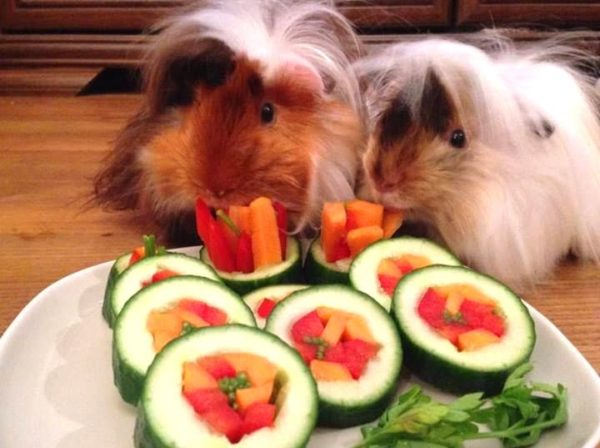
Tree branches are also fed to rodents no more than three to four times a week. At the same time, the owner should know that the branches of oak and coniferous trees are contraindicated for pigs.
רשימה פון פּראָוכיבאַטאַד פּראָדוקטן:
- מאַקאַראָנען;
- מילכיגס;
- meat, sausage, fish;
- פּאַטייטאָוז;
- זיסוואַרג;
- ברויט;
- peas, beans, beans;
- שוועמל;
- ציבעלע און קנאָבל;
- עגגס.
Guinea pig feeding rules:
- You can’t leave your pet without food even for one day. If the animal starves for 18-20 hours, irreversible changes begin to occur in its digestive system, which often leads to the death of the animal;
- fresh hay should always be in the rodent’s cage;
- pieces of vegetables and fruits are fed to pets no more than twice a day;
- the diet of animals should be varied, so the types of vegetables for daily feeding should be alternated;
- in winter, when there is no fresh grass, the domestic guinea pig is given sprouted cereal grains;
- animals should not be overfed. The daily dose of food for a guinea pig should not exceed 20-30% of its own body weight. If the animal’s daily food intake exceeds the allowable dose, this threatens to develop obesity;
- it is necessary to introduce new products into the pet menu gradually, observing its condition after feeding. With a change in the consistency of feces, skin rashes or lethargy of the mumps, this product is excluded from his diet;
- pigs drink little water, but their drinking bowl should always have clean boiled water.
Important: all animal feed products must be fresh and of high quality. Rotten hay, grass collected near highways and rotten vegetables and fruits should not be given to pets.
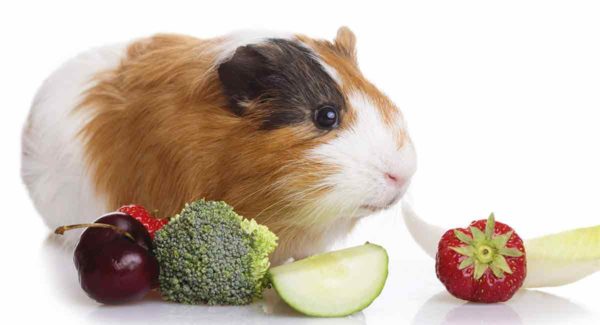
Guinea pig care tips
Small rodents are very clean and constantly clean their fur coat, especially after eating. But just because a guinea pig can take care of its own fur doesn’t mean it doesn’t need to be looked after. After all, caring for guinea pigs includes not only hygiene procedures, but also regular cleaning of their homes.
How to care for a guinea pig at home:
- pets with long hair (alpaca, sheltie or angorok breeds) need to be combed regularly so that their hair does not get tangled and does not fall into tangles. It is not necessary to comb short-haired rodents, but pigs like this massage, so you can periodically pamper them with a pleasant procedure;
- despite their name, these animals do not like to swim and are reluctant to take a bath. Yes, and bathing pets is often not recommended, and they do it only when absolutely necessary;
- bathe the animal only in warm water, using baby shampoo and making sure that water does not get into the ears and eyes. At the end of the water procedures, the animal is wrapped in a thick towel and held in his arms until his hair dries. After bathing, it is advisable to comb the pig;
- sulfur and dirt accumulate in the auricles of animals, and if they are not cleaned, the animal may even become deaf. To avoid this, the inner surface of the pet’s ears is regularly inspected and cleaned with a soft cloth.
Any hygiene procedures are stressful for the animal. Therefore, while bathing or cleaning the ears, the pet is held firmly, but carefully so that it does not break out and is not injured.
Tips for caring for the cage and accessories:
- light cleaning of the cage is carried out once every three to four days, and general – once a month;
- before starting to wash the cage, the fluffy tenant is placed in a box or a deep bowl;
- before cleaning the housing, all items are removed (feeder, drinker, house, toys);
- pour out the dirty filler from the pallet. Then the pan is washed with clean water and wiped dry;
- plastic or glass inventory is also washed in clean warm water and left to dry;
- it is not necessary to wash the house, it is enough to wipe it with a damp piece of cloth;
- the bars of the cage are also wiped with a damp cloth;
- upon completion of the cleaning, the pallet is returned to its place, a layer of clean filler is covered, a feeder, a sennitsa, a drinker and a house are installed in their places.
During the monthly general cleaning, in addition to washing the cage and accessories, all items are disinfected using soda or vinegar essence for this purpose. Do not use chemical disinfectants.
Games, training and domestication of a pet
Do not believe the popular belief that guinea pigs are boring and lazy, who only do what they eat and sleep. In fact, these are active, playful and sociable pets that will enjoy spending time playing with the owner.
Furry animals are quite smart and quick-witted, so they are easily tamed and can be taught to perform simple tricks.
Domestication of the animal
In order for a small pet to get used to the owner and begin to trust him, you should devote a lot of time to communicating with the pets.
In the early days, approaching the cage, the owner should talk quietly and affectionately with the rodent until he begins to recognize the voice of the owner.
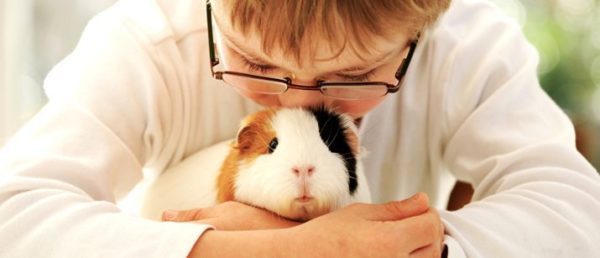
The next step is to feed the animal with a treat from your hand. When the pig comes up for a treat, you should stand still, do not try to grab it in your arms and do not make sudden movements. After a few days, the rodent itself will begin to run up to the owner’s hand, checking for treats.
When the animal gets used to the voice and smell of the owner, you can try to gently pull it out of the cage and hold it in your arms. If the animal is frightened, you should calm him down by stroking his back and gently talking to him.
As soon as the animal is convinced that the owner does not threaten him with anything, the pet will be happy to sit on his hands or knees.
גיני חזיר שפּילערייַ
The easiest way to get your pig interested in playing is to hide treats in different parts of the cage. Let the animal feel like a detective, looking for a treat.
You can invite the animal to play football by placing a rustling paper ball in its home. The pig will take a lot of pleasure pushing the ball with his head, watching how he rolls around the cage.
Another fun homemade toy can be an ordinary cardboard box in which several holes are cut to fit the pet. The rodent will be delighted to fiddle around inside the box, entering one “door” and exiting another.
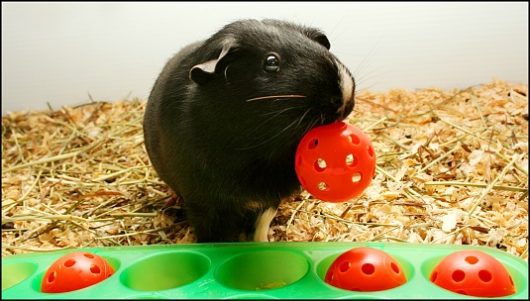
Rodent training
Using a treat as a reward, you can teach a guinea pig to respond to its name, to beg for a favorite treat, to spin around its axis.
In order for the pet to respond to its name, each time pouring food on it or treating it with a tidbit, you should repeat its nickname. After a couple of days, the rodent, having heard its name, will run to the owner, begging for a treat.
You can also teach your pig to turn around with treats. For this purpose, they give the animal a sniff of a treat and slowly turn it around the pig. The rodent will begin to turn after the owner’s hand. And when he makes a full turn, he is rewarded with a treat.
How to properly handle a guinea pig
These fluffy animals are fragile and shy. Guinea pigs like attention and care, but a small pet must be handled carefully, gently and delicately:
- these rodents are afraid of loud sounds, so you can’t turn on loud music or TV in the room with their cage;
- it is strictly forbidden to throw various objects into their home! This will lead to the development of nervous stress in the pig, which can result in the death of the pet;
- you can’t shout at rodents or shake their cage;
- Animals do not tolerate violent actions. Therefore, one should not pull the pet out of the cage or take it out of the house against the will of the pet. An exception may be when the animal is sick and needs to be examined by a veterinarian;
- it is forbidden to lift the pig by the “scruff” or by the paws;
Important: Guinea pigs love peace and quiet. And these quivering gentle rodents will feel cozy and comfortable only in the house where there is a calm and cozy atmosphere.
Keeping a guinea pig at home is not that difficult. The main thing is to properly equip the cage of the animal, follow the recommendations for feeding it, and devote some time to communicate with a small pet. After all, only a caring and loving owner can a guinea pig live a long and happy life.
Video: how to care for a guinea pig at home
How to care for a guinea pig at home: rules and tips for beginners
3.2 (קסנומקס%) 335 וואָוץ



